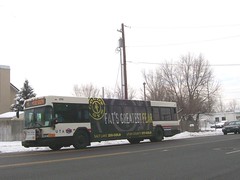Today I will begin a four part series on what is really costing the UTA. As regular readers will know, I have been critical of organizations such as the Anti-Hunger Coalition and the Transit Riders Union as they often become pawns of anti-transit forces and also demonize the rail program as being cause of all the problems.
However, in this series I will point out the most costly program the UTA has to deal with and that is satisfying ADA requirements. Let me make it clear I am not trying to debate the needs of the ADA, I am point out what it cost to deal with it. In part one I will deal with the regular bus system, in part two I will discuss Flextrans and in part three I will go over the latest demands of the ADA, and fourth I will discuss some solutions.
In the late 70's wheelchair lifts started appearing on buses. The SCRTD in Los Angeles was one of the first agencies to purchase them with their AMG buses in 1977. However, until the ADA took effect, most transit agencies avoided them.
One of the problems with wheelchair lifts is that they can be extremely costly to operate and have been prone to multiple troubles. In addition the sidewalks need to be designed to be able to let the driver safely deploy the lift and everyone familiar with Salt Lake area sidewalks know they were not designed for that.
As a solution to problem of the lifts the bus manufacturers started coming out with low floor buses such as the Gillig Advantage pictured operating on route 45.
The idea of the low floor bus first came out with the Transbus program by the Federal Government in the late 70's. However most of the current bus manufacturers pulled out the program due to escalating cost, however when the ADA came along the bus manufacturers again started looking at the low floor buses.
There is two advantages of low floor buses:
-No Wheelchair Lift
-Faster loading and unloading of passengers if the transit system takes advantage of them (which UTA has not except in the poorly design BRT scheme on 3500 South).
There also several disadvantages:
-Reduced Seating Capacity
-Increase maintenance cost especially the front end
-Not Customer Friendly
There is other issues but those can be traced to poor build quality due to the transit systems not holding the manufacturers feet to the fire to build a better bus.
In conclusion, transit systems lost capacity and faced increased cost to cooperate the ADA. However, the real cost is Paratransit and in the next part of series I will go over the cost of providing Paratransit (Flextrans) service.

No comments:
Post a Comment